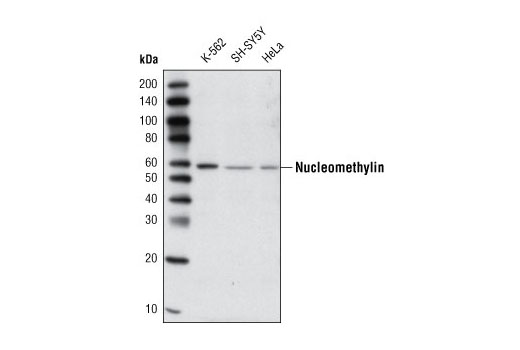WB
H
Endogenous
58
Rabbit
#O43159
23378
Product Information
Product Usage Information
| Application | Dilution |
|---|---|
| Western Blotting | 1:1000 |
Storage
Specificity / Sensitivity
Species Reactivity:
Human
Source / Purification
Polyclonal antibodies are produced by immunizing animals with a synthetic peptide corresponding to the amino terminus of the human Nucleomethylin protein. Antibodies are purified by protein A and peptide affinity chromatography.
Background
Nucleomethylin (NML), also known as ribosomal RNA-processing protein 8 (RRP8) and human cerebral protein 1 (Hucep-1), is a nucleolar protein (1,2). NML interacts with the histone de-acetylase protein SirT1 and histone methyl-transferase protein SUV39H1 to form the energy-dependent nucleolar silencing complex (eNoSC) that regulates ribosomal RNA (rRNA) transcription in response to changes in the energy state of the cell (2). As energy levels in the cell decrease due to caloric restriction, eNoSC binds to rRNA genes and represses transcription by SirT1-mediated de-acetylation of histones and SUV39H1-mediated methylation of histone H3 on Lys9. NML binds to di-methylated Lys9 of histone H3 and likely functions in the recruitment and spreading of eNoSC along the rRNA genes (2). NML also contains a methyltransferases-like domain, which binds to S-adenosyl-methionine (SAM) and is required for eNoSC function (2). By limiting the transcription of rRNA genes during caloric restriction, eNoSC promotes the restoration of energy balance and protects cells from energy-dependent apoptosis.
Species Reactivity
Species reactivity is determined by testing in at least one approved application (e.g., western blot).
Western Blot Buffer
IMPORTANT: For western blots, incubate membrane with diluted primary antibody in 5% w/v BSA, 1X TBS, 0.1% Tween® 20 at 4°C with gentle shaking, overnight.
Applications Key
WB: Western Blotting
Cross-Reactivity Key
H: human M: mouse R: rat Hm: hamster Mk: monkey Vir: virus Mi: mink C: chicken Dm: D. melanogaster X: Xenopus Z: zebrafish B: bovine Dg: dog Pg: pig Sc: S. cerevisiae Ce: C. elegans Hr: horse GP: Guinea Pig Rab: rabbit All: all species expected
Trademarks and Patents
Limited Uses
Except as otherwise expressly agreed in a writing signed by a legally authorized representative of CST, the following terms apply to Products provided by CST, its affiliates or its distributors. Any Customer's terms and conditions that are in addition to, or different from, those contained herein, unless separately accepted in writing by a legally authorized representative of CST, are rejected and are of no force or effect.
Products are labeled with For Research Use Only or a similar labeling statement and have not been approved, cleared, or licensed by the FDA or other regulatory foreign or domestic entity, for any purpose. Customer shall not use any Product for any diagnostic or therapeutic purpose, or otherwise in any manner that conflicts with its labeling statement. Products sold or licensed by CST are provided for Customer as the end-user and solely for research and development uses. Any use of Product for diagnostic, prophylactic or therapeutic purposes, or any purchase of Product for resale (alone or as a component) or other commercial purpose, requires a separate license from CST. Customer shall (a) not sell, license, loan, donate or otherwise transfer or make available any Product to any third party, whether alone or in combination with other materials, or use the Products to manufacture any commercial products, (b) not copy, modify, reverse engineer, decompile, disassemble or otherwise attempt to discover the underlying structure or technology of the Products, or use the Products for the purpose of developing any products or services that would compete with CST products or services, (c) not alter or remove from the Products any trademarks, trade names, logos, patent or copyright notices or markings, (d) use the Products solely in accordance with CST Product Terms of Sale and any applicable documentation, and (e) comply with any license, terms of service or similar agreement with respect to any third party products or services used by Customer in connection with the Products.
